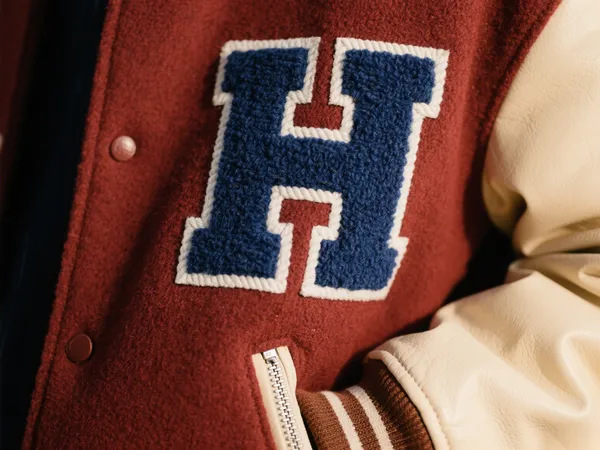Los parches de chenilla son una de las opciones más populares para añadir textura, profundidad y un toque de lujo a la ropa y los accesorios. Ya sea que diseñes parches personalizados para chaquetas, bolsos o sombreros, aprender a hacer parches de chenilla es esencial para dominar esta singular técnica de bordado. En esta publicación, exploraremos las diferencias clave entre usar hilos de chenilla gruesos y finos, los beneficios de cada uno y cómo estas opciones pueden ayudarte a crear el parche perfecto para cualquier proyecto.

El poder de los parches de chenilla: una combinación única de textura y artesanía
El bordado de chenilla destaca por su textura suave y aterciopelada, que otorga a los diseños una calidad tridimensional y táctil. A diferencia del bordado plano tradicional, los parches de chenilla utilizan bucles de hilo en relieve para crear un efecto aterciopelado y lujoso, perfecto para añadir interés visual a prendas y accesorios. Pero para lograrlo, es necesario comprender cómo los diferentes tipos de hilo de chenilla pueden afectar el resultado final.
Hilo de chenilla grueso: atrevido, texturizado y visiblemente llamativo

Ventajas:
- Fuerte efecto 3D y plenitud: Los hilos gruesos de chenilla (de 8 a 16 hebras) forman bucles elevados, grandes y visibles. Esto da como resultado un parche con un aspecto muy táctil, llamativo y tridimensional, ideal para logotipos o diseños que deban destacar, especialmente en prendas de abrigo como chaquetas o sudaderas.
- Aspecto vintage y artesanal: El hilo más grueso se presta naturalmente a una estética retro o robusta. Si creas parches para ropa de trabajo o diseños de inspiración vintage, la chenilla gruesa aporta un toque auténtico y artesanal.
- Durability: La construcción de hilo más denso ofrece mayor durabilidad y resistencia al desgaste, lo que lo hace ideal para artículos de uso frecuente, como bolsos y ropa de abrigo.
Desventajas:
- Peso más pesado: El uso de hilo más grueso aumenta el peso del parche, lo que puede afectar la caída general de telas más ligeras. Es importante considerar el peso de la prenda y el uso previsto antes de elegir un parche de chenilla grueso.
- Menos precisión en los detalles: Si bien la textura es audaz, los detalles finos o los diseños intrincados pueden perderse en el hilo grueso, lo que puede difuminar los bordes o el texto pequeño.
Aplicaciones ideales: La chenilla gruesa es perfecta para logotipos llamativos, diseños grandes, prendas de abrigo y ropa urbana de moda. También es ideal para artículos de decoración del hogar, como mantas o almohadas, que necesitan un aspecto lujoso e impactante.
Sugerencia de imagen: Un primer plano de un parche de chenilla gruesa en una sudadera con capucha o una mochila, que muestra su efecto tridimensional y su volumen.
Hilo fino de chenilla: fino, detallado y suave al tacto.

Ventajas:
- Alta precisión de detalle: Los hilos finos de chenilla (de 20 a 40 hebras) permiten una costura más precisa, facilitando la creación de diseños detallados e intrincados. Ya sea texto pequeño, logotipos o patrones finos, este tipo de hilo proporciona una excelente claridad y bordes definidos.
- Ligero y cómodo: La chenilla fina ofrece una sensación más ligera y suave, ideal para prendas de uso en contacto con la piel, como camisetas, ropa de bebé o ropa deportiva. Su ligereza la hace cómoda para el uso diario.
- Transpirabilidad: Debido a la naturaleza más fina de los hilos, los parches de chenilla delgados tienden a tener una mejor transpirabilidad, lo que garantiza la comodidad, especialmente en climas más cálidos.
Desventajas:
- Menos efecto 3D: La textura de los hilos finos de chenilla no destaca tanto como la de los hilos más gruesos. Si bien sigue siendo afelpada, no tiene el mismo volumen llamativo que la chenilla gruesa.
- Menor impacto visual: Si buscas un estilo atrevido y de inspiración vintage, es posible que la chenilla fina no tenga el mismo impacto visual que su contraparte más gruesa.
Aplicaciones ideales: La chenilla fina es perfecta para detalles finos e intrincados en prendas como camisetas, polos o ropa infantil. También es ideal para proyectos que requieren gran claridad y comodidad, como gorras ligeras o parches personalizados para telas delicadas.
Sugerencia de imagen: Un primer plano de un parche de chenilla fino en una camiseta suave, que resalta la claridad del diseño y la textura suave y lisa.
Cómo elegir la chenilla adecuada para su proyecto de parche
Comprender cómo hacer parches de chenilla y elegir el tipo de hilo adecuado es fundamental para crear un parche que se ajuste a tus necesidades de diseño y funcionalidad. Aquí tienes algunos consejos para ayudarte a decidir:
- Para diseños atrevidos y llamativos: Elige chenilla gruesa para diseños que necesiten ser visibles e impactantes. Es perfecta para logotipos o diseños grandes en prendas de abrigo.
- Para detalles finos e intrincados: Opte por chenilla fina para diseños más pequeños y detallados donde la precisión y la claridad son clave.
- Considere la tela: La chenilla más gruesa y pesada funciona bien en telas más pesadas como mezclilla, algodón y lona, mientras que la chenilla más fina es ideal para telas más livianas como camisetas y ropa deportiva.
Conclusión: Cómo perfeccionar tus parches de chenilla personalizados
Crear el parche de chenilla perfecto requiere un equilibrio entre diseño, elección de hilo y técnicas de producción. Ya sea que busque el impacto impactante y texturizado de la chenilla gruesa o la delicadeza y la suavidad de la chenilla fina, comprender las ventajas y aplicaciones de cada tipo le ayudará a lograr el parche personalizado perfecto. En QingHan, nos especializamos en la elaboración de parches de chenilla de alta calidad que satisfacen las necesidades únicas de nuestros clientes, desde diseños grandes y llamativos hasta detalles intrincados y finos.
Al elegir el hilo de chenilla adecuado y aplicar las técnicas adecuadas, puede crear parches personalizados que no solo mejoran la estética de sus productos, sino que también añaden un toque personal y de alta calidad a cada diseño.
Con este enfoque, sus parches se destacarán, dejando una impresión duradera y brindando comodidad, durabilidad y atractivo visual.



